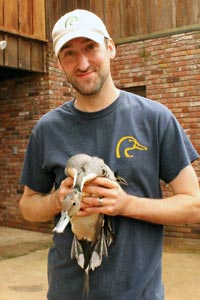LaDIA Fellows Program
About | Past Fellows | How to Apply
2017 Fellows
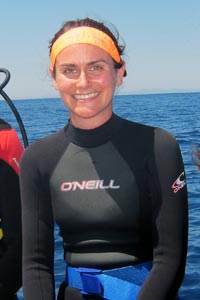
Abigail Bockus
LUMCON
What I Do:
I study marine organisms’ ability to adapt to their environment and how this affects physiological performance, distribution and ecosystem stability. Determining how temperature, salinity, hypoxia, acidification and pollution influence species success allows me to predict the impact of land use and climate change on coastal habitat resilience and fisheries production.
Why It’s Important:
As a comparative physiologist, I have a continued interest in examining the underlying mechanisms driving species and habitat stability, especially as these dynamics shift due to human impacts and climate change. This summer, my group will focus on how freshwater diversions influence essential habitats of juvenile brown shrimp, a species supporting one of the largest commercial fisheries in Louisiana. We will also begin work examining how oil exposure affects coastal fish and invertebrates’ ability to adapt to environmental variability (e.g. salinity, hypoxia). These are some of the many ways in which defining the physiological plasticity of marine species can be used to advise protection and restoration efforts in Louisiana’s deltas, estuaries and coasts.
There is also a tremendous need to ensure fisheries success in a future of changing environmental conditions and exacerbated global food shortages. A substantial part of my research program focuses on optimization strategies for commercial development and sustainability off the Louisiana coast and across the Gulf of Mexico. We are working to characterize species specific nutrition and condition requirements to promote local aquaculture and fisheries production. This research can also be used to inform regional conservation and management practices for economically important target species.
 Marshall Bowles
Marshall Bowles
LUMCON
What I Do:
My research focuses on the microorganisms living in coastal and marine environments. I often determine how many microorganisms live in an environment by counting them, how they survive by measuring environmental parameters, and who they are by evaluating their genomes.
Why It’s Important:
Earth has a great abundance of microbes (e.g. bacteria), indeed they outnumber humans by much more than a million times! We know microbes, though small, change how chemical elements move on Earth. My goal is to understand how microbes in the coast and the ocean interact with the world around them. This means that I typically try to figure out how microbes actually change the chemistry in their environment or are themselves influenced by the activity of humans. Two major issues related to this are oil spills and sea level rise, as they both influence microbial processes. When oil is released into the ocean microbes that are able to ‘eat’ oil quickly grow in and break it down. So a typical goal would be to understand what enables a microbe to break down oil and how abundant that microbe may be. Likewise, sealevel rise will activate different sets of microbes and potentially change the kinds of chemicals released from coastal environments. In Louisiana understanding oil spills and sea level rise is very important due to cultural and economical implications.
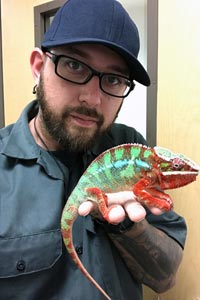 Raul E. Diaz, Jr.
Raul E. Diaz, Jr.
Southeastern Louisiana University
Department of Biology
What I Do:
We study the embryonic basis of how reptiles look different (at a cellular and genetic level) and why they look different (understand their function in their habitat). We integrate together body form and ecological function to help protect their environment.
Why It’s Important:
When studying biodiversity, one aspect remains missing, and that is documenting the diversity of body types found in nature and understanding the embryonic basis for how these species differences form. More importantly it allows us to better link an organism’s body with how it functions in its environment, such as structures associated with feeding, camouflage, running or climbing. This approach ties together various biological disciplines such as Ecology, Embryology and genetics, and evolutionary history that can present a better understanding of how an organism is able to specifically survive in its environment and in turn can be used to help protect the species and the environment in which it lives. In the lab and field, we study the embryonic development of lizards, snakes, crocodilians, turtles and birds to better understand how their different body forms begin to look different during early development. We also link the development of reptiles as potential models for studying human congenital malformations such as cleft hands/feet and craniofacial skeletal defects like craniosynostosis.
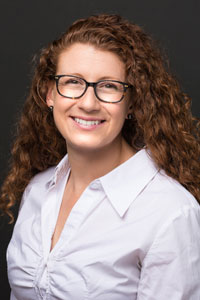 Aimee M. Hollander
Aimee M. Hollander
Nicholls State University
Department of Biological Sciences
What I Do:
I study how diseases caused by bacteria and viruses make people sick and how these diseases are transmitted. My ultimate goal is to do research that will result in preventing the spread of various diseases that are transmitted between people, mosquitoes and animals along the Louisiana coastlines.
Why It’s Important:
I study how humans,animals and insects are involved in the spread of diseases particularly those caused by viruses and bacteria. I am currently investigating the various types of mosquito populations that live along the Louisiana coastline and if they are carrying diseases to both the human population as well migratory birds and other animals.
In addition to this research, my lab is also investigating how human use of cigarettes affects our coastlines. Cigarette butts litter was outlawed in 2014 by the state of Louisiana. We are interested in, investigating how metals and chemicals that are in these butts affect marine and wetland environments in hopes of increasing cigarette receptacles in recreational areas in Louisiana.
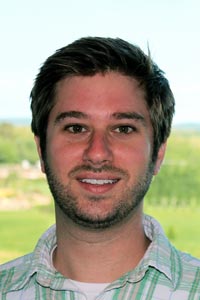 Steve Midway
Steve Midway
Louisiana State University
Department of Oceanography and Coastal Sciences
What I Do:
Fishery resources are generally publicly-owned, and therefore states, countries, and other jurisdictions have a responsibility to manage them sustainably into the future. When managed appropriately, fisheries provide employment, revenue, food, and numerous other benefits. My research attempt to improve our knowledge of fish and fisheries, so that the best science can go into decisions regarding the resource use.
Why It’s Important:
Given the public ownership of most fishery resources combined with the demonstrated ecological and ecosystem importance of healthy fish populations, my research is geared toward improving our understanding of fish and fisheries. Although a complete understanding of successes and failures of harvested populations is not known, fishery science has advanced significantly in the past century to the point where management recipes for success are robust. That being said, each species and population is different and may react to its environment or respond to harvest in ways we do not fully understand. The importance of my research is to address pressing and contemporary questions at the interface of what we know and don’t know about fished populations, such that the management of populations is done in the best way possible. Additionally, even without any harvest, it is widely accepted that the the earth’s climate and ecosystems are changing. Because fish are an integral part of freshwater, estuarine, and marine ecosystems, it is understood that fish will also change as a response to a changing environment. Understanding the dueling dynamics of variable harvest and a variable environment insure that relevant questions with ecological and socio-economic outcomes need to be understood.
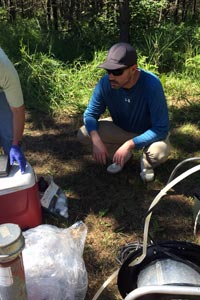 David C. Podgorski
David C. Podgorski
University of New Orleans
Department of Chemistry
What I Do:
Water transports dissolved organic compounds through aquatic ecosystems. Organic compounds may be solubilized and subsequently broken down by changes in chemical composition from sunlight and microorganisms. My research examines the molecular-level transformations in chemical composition and structure that control dissolution, reactivity and breakdown of organic compounds in the environment.
Why It’s Important:
A major challenge in environmental geochemistry is the determination of the chemical composition of Earth’a major carbon reservoirs in marine and terrestrial systems. These reservoirs exchange carbon with the atmosphere and can vary between a source or sink for carbon dioxide (CO2) in changing climate. Modeling rates of exchange between these reservoirs requires a comprehensive understanding of the correlation between chemical composition and reactivity of compounds in the organic carbon pool. Moreover, inter-reservoir conversion between refractory and labile carbon pools as a result of environmental factors and processing must be considered in these models. Identification of the compounds that are susceptible to conversion by photochemical and microbial processes is required for accurate estimates of CO2 flux between organic carbon reservoirs and the atmosphere.
My research combines laboratory and field experiments to understand the structure of organic compounds and the molecular level changes to these compounds from photochemical and microbial degradation processes. Laboratory experiments utilize physical separation techniques to isolate chemical classes of compounds to test reactivity and associated molecular-level transformations. The information obtained from laboratory experiments is applied to filed studies ranging from water quality in springs to monitoring of natural attenuation and toxicity of organic contaminates in groundwater.
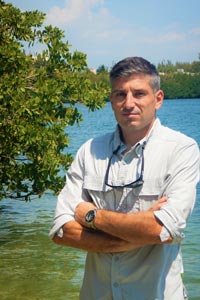 Guillaume Rieucau
Guillaume Rieucau
LUMCON
What I Do:
My research explores how predation, environmental conditions, anthropogenic disturbances and fishery activities affect the behavior of ecologically and economically important fish species in marine and estuarine ecosystems. I am developing an innovative framework that uses fish behaviors as bio-indicators for impact studies and restoration programs in coastal and marine environments.
Why It’s Important:
My research aims at understanding the complex interactions between human activities/perturbations and natural resources, trophic interactions and food web dynamics in critical Louisiana’s coastal and estuarine ecosystems. I am particularly interested in the ecological and evolutionary processes that mediate the behavioral responses of marine and estuarine nektonic species. I study how schooling fish (from forage fish to top-predators) respond to a fluctuating environment. I explore the behaviors of local estuarine and marine fishes with the ultimate goals being to i) address ecological, management and conservation issues and ii) link findings from research with environmental education. Louisiana’s coastline and estuarine systems are by far ones of the most humanly and industrially affected ecoregions of the United States. Negative anthropogenic disturbances, such as habitat loss due to flooding or pollutant exposure, can have profound effects on the health and productivity of marine ecosystems. To understand the ecological consequences of anthropogenic perturbations, it is necessary to ascertain how these stressors affect the behavioral responses of ecologically important local species, such as forage fishes and their predators known to play a pivotal role in marine ecosystems. I am addressing these questions during laboratory and in situ experimentations.
Kevin Ringelman
Louisiana State University
Department of Renewable Natural Resources
What I Do:
I study the ecology of waterfowl an their wetland habitats, on both the breeding grounds in the north and the wintering grounds here in Louisiana. The goal of my research is to understand what environmental factors are important in driving duck populations, so we can better manage these charismatic species.
Why It’s Important:
The management of North American waterfowl is a premier example of a successful conservation program. Emerging from the devastation of market hunting in the 1800s was a series of laws, regulations and funding mechanisms that formed the foundation of modern wildlife conservation in the United States. Science-based waterfowl management took hold in the late 1980s, which provided rigor and transparency to conservation, but also underscored how little we really knew about the drivers of waterfowl populations.
We have learned much in the past three decades, and thanks to a series of wet years on the prairie breeding grounds, waterfowl populations are at an all time high. But there is still much work to be done. For example, my research tried to fill in the gaps of what we know about waterfowl ad their nest predators, and also how waterfowl use various marsh habitats at different times of year, and how human disturbance affects their behavior. Such knowledge is critical for developing regional conservation strategies and actually implementing habitat protection and management on the ground.
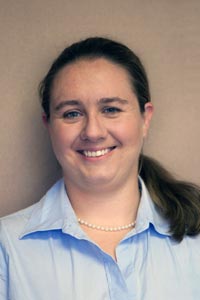 Kelly L. Robinson
Kelly L. Robinson
University of Louisiana at Lafayette
Department of Biology
What I Do:
My research as a marine scientist focus on the role of climate and human-driven environmental change as drivers of variability in plankton abundance and distribution in coastal oceans, with an emphasis on jellyfish. I am particularly interested in understanding how variations in these animals affect energy flow in coastal food webs and fisheries production.
Why It’s Important:
The seafood industry is a key component of the nation’s and world’s economy, generating 260 billion USD per year and supporting 1.4 million jobs in the United States alone in 2014. In developing nations, seafood is a critical to food security as it is often the primary source of protein. All animals supporting fisheries like crab, salmon, anchovies, and oysters start their lives as zooplankton — small, free-floating animals in the ocean that are vulnerable to environmental change.
My research focuses on understanding how man-made and climate forces affects zooplankton, and what the consequences of those changes are to upper-level consumers like large fish, sea birds, and marine mammals. This research is important because: (1) coastal ecosystems are subject to stressors operating at range of space and time scales, (2) plankton are the foundation of food webs supporting fisheries and coastal economies, (3) environmentally-sensitive plankton serve as harbingers of ecosystem-level transformation. By understanding response of plankton to perturbations like climate variability (i.e. El Nino events) and long-term change (i.e. warmer ocean temperatures) and altered inputs of riverine sediment and nutrients, we can better predict the effect those changes will have on economically and culturally important fisheries.
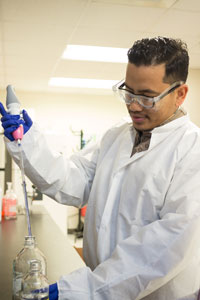 Samendra Sherchan
Samendra Sherchan
Tulane University
Department of Global Environmental Health Sciences
What I Do:
Access to clean water is paramount to human health and environmental protection. Due to climate change and population growth, maintaining adequate water quality and quantity is becoming extremely difficult. My research is in the area of environmental health microbiology focusing on the survival, transport and control of emerging pathogens in water.
Why It’s Important:
My research program addresses critical issues at the intersections of water quality, human health and environmental protection. A clean water supply is crucial to the health of the human population, economic interests and environmental protection. However, nationwide concern in the United States has recently been focused upon unsafe drinking water. Much of this concern has been precipitated by the infamous current “Flint incident” in which a several public health emergency was caused by lead poisoning. Similar water problems have occurred in the State of Louisiana. Recreational waters, shellfish farms, beaches and drinking water systems were compromised after Hurricane Katrina and Deepwater Horizon Oil Spill. Thus, considering the serious problem of fecal water pollution, it is important to determine the source(s) of fecal contamination in order to prevent infections diseases and assure water quality to protect human and environmental health. Yet, traditional methods of pathogen detection using cell culture and dilution and plating are time-consuming and labor-intensive. My research focuses on developing rapid molecular detection techniques for water-borne/based pathogens including emerging pathogen such as brain eating amoeba.
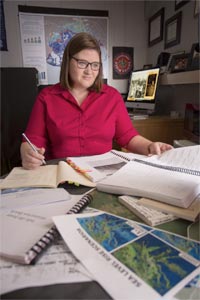 Heather Stone
Heather Stone
University of Louisiana at Lafayette
Department of Curriculum and Instruction
What I Do:
Louisiana is losing a football field of wetlands every hour. Soon I’ll be using virtual reality to help K-12 students understand how this land loss looks, sounds, and feels.
Why It’s Important:
To save the coast, we have to know the coast—what it gives us and how its loss will change our lives. My lesson plans are designed to make these connections. When students immerse themselves in the coast’s beauty and bounty, they’ll not only expand their view of the world, they’ll learn how to save the landscape in their own backyard.
Some kids in south Louisiana grow up exploring south Louisiana’s wetlands. But not all young people have access to the outdoors. I want to bring the wetlands to the classroom so that students everywhere in Louisiana and eventually beyond our state can see for themselves what the coast gives us and what we stand to lose. Virtual reality offers students an immediate experience, but I also wanted to ground my lessons in a community that is on the front lines of land loss. That is why I am working with the Biloxi-Chitimacha-Choctaw tribe, whose ancestral home is on Isle de Jean Charles (IdJC). The lessons focus on the science behind the land loss and also examine the cultural impacts that land loss has on communities.
Creating lessons in virtual reality gives students a connection to a real community whose way of life is vanishing. These connections increase students’ awareness of what can happen if they do not take care of the environment. When we show young people what we are losing and invite them to join in making a difference, we nurture a new generation of coastal stewards. In so doing, we’ll help the coast and our communities. Students who better understand the coast will grasp the issues and how they can help. They may also be inspired to investigate new fields of study and work, from water management and construction to biology. In this way, learning about our coast becomes a vehicle for creating new action and opportunities.
I have created 360 degree oral histories with Tribal members. Complementing these interviews is drone footage of IdJC, as well as computer simulations that detail the history of changes over the last 100 years. The computer simulations graphically represent the land loss, and the interviews and drone footage are authentic views of the island and its people.
By creating virtual reality lessons focused on a community students can relate to and understand their coast. This program gives visual and emotional context to otherwise abstract land loss statistics. Through this process we can create awareness and inspire the next generation of coastal stewards.
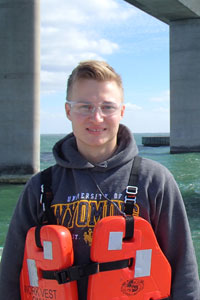 Jovan Tatar
Jovan Tatar
University of Louisiana at Lafayette
Department of Civil Engineering
What I Do:
My research focuses on the use of advanced non-traditional building materials for applications in residential buildings and bridges, and trying to understand how these materials respond to harsh environmental conditions in the coastal regions.
Why It’s Important:
Buildings and bridges located in coastal regions are exposed to a combination of severe environments during their lifetime: high levels of UV irradiation, diurnal temperature changes, tidal fluctuations, saltwater spray, high humidity, etc. These conditions tend to accelerate the degradation of building materials, and increase the probability of collapse, particularly when such structures are subjected to extreme loads during natural disasters (hurricanes, tsunamis, earthquakes, floods, etc.). As structures in coastal Louisiana and worldwide age, the costs associated with maintenance, repair, retrofitting, and replacement continue to rise. Due to increasing costs, the use of more efficient materials and construction techniques becomes increasingly relevant in the current economy. The goal of my research is to develop and implement advanced non-traditional materials that can be used to: (1) recover the loss in strength due to environmental degradation of structures; (2) reduce the rate of degradation of structures in coastal environments; and (3) improve the resilience of critical infrastructure. Through the use of advanced non-traditional materials the negative impacts of construction on the coastal ecosystems can also be reduced. Additionally, this research can mitigate loss of property and life during a natural catastrophe while also allowing faster repair and rebuilding.
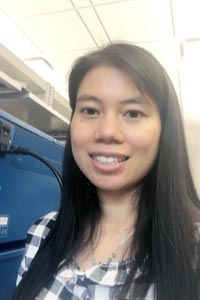 Xiuping Zhu
Xiuping Zhu
Louisiana State University
Department of Civil and Environmental Engineering
What I Do:
My research is focused on development of electrochemical systems (such as fuel cells and batteries) for sustainable water and wastewater treatment with energy recovered from water sources.
Why It’s Important:
There are large amounts of energy contained in wastewater and natural water bodies. For example, the potential source of renewable energy in wastewater is about 150 billion kWh of energy (~17GW of power) every year in the US, which is 6 times of the energy consumed for wastewater treatment. The potential power production from estuarine salinity gradient energy between seawater and river water is estimated to be 1.4-2.6 TW, which is similar to the current worldwide demand for electrical power (~2TW). If part of energy can be recover from wastewater and natural water bodies, it could make our water and wastewater treatment sustainable in terms of energy demand. My research is focused on development of electrochemical systems for sustainable water and wastewater treatment with energy recovered from water sources. I have investigated microbial fuel cells (MFCs) to treat domestic hydrogel expansion (HEx) for sailinity gradient energy recovery. Now my research group aims to develop more electrochemical systems for sustainable water and wastewater treatment with low energy consumption and even positive energy generation.

